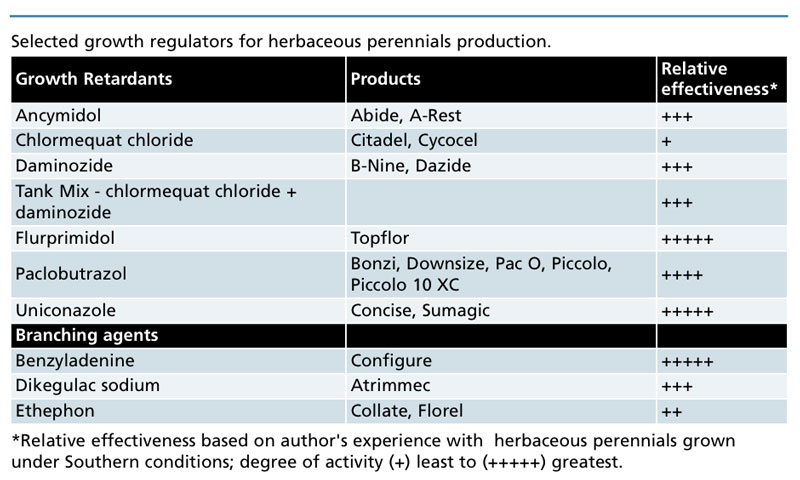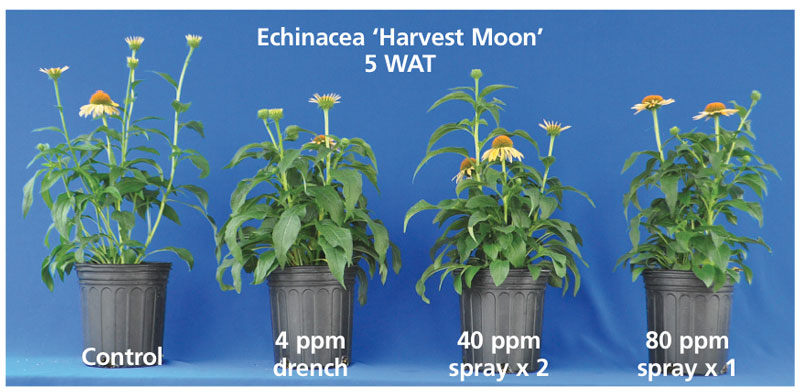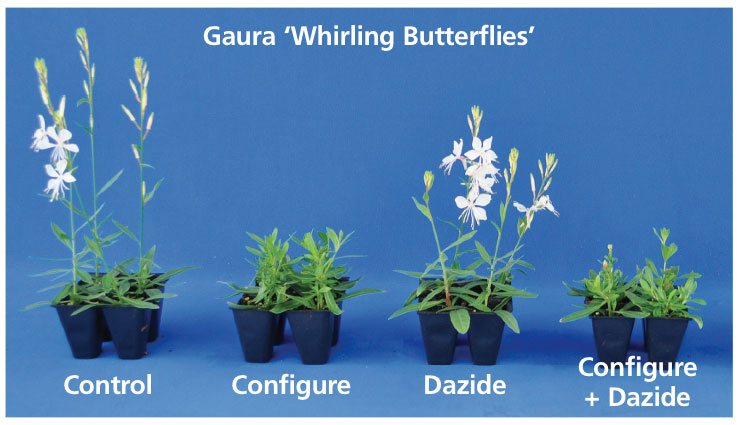8/1/2021
Using Growth Regulators Wisely
Joyce Latimer
Building a plant growth regulator (PGR) program for any crop begins with knowing your options and how they fit into your overall production practices and strategy. Often perennials are more aggressive growers than many of the other “well-bred” greenhouse crops, tending to stretch and become leggy or simply overgrow their pots before their scheduled market date.
While there have been major advances in breeding herbaceous perennials that are more amenable to container production, the tremendous diversity of species and aggressive growth of many of these crops makes intervention advisable, if not critical. However, it’s important that chemical growth regulators be considered as another tool in your production toolbox to complement your existing strategy. There are two primary groups of growth regulators that will be discussed here: growth retardants and branching enhancers.
Plant growth regulation
Plant growth retardants are used to manage plant growth and quality during production to produce the most marketable plant. Benefits of using growth retardants include using less bench space per plant, meeting shipping height/rack requirements, shipping more plants per load and having a buffer period of growth control if needed for holding the product. However, even if growth regulation isn’t critical to producing a good crop, growth retardants can improve plant quality by deepening the green color, strengthening stems and increasing stress (drought and temperature) tolerance, which results in less shrinkage and a longer shelf life.
 Another factor affecting the need for and timing of chemical intervention in perennial production is the use of outdoor production spaces. While the higher light outdoors assists with moderating plant stretch—assuming adequate spacing—the plants are generally less accessible for future applications. Therefore, when we develop a PGR program for outdoor production, we emphasize early application using the more persistent growth retardant chemistries and application methods that enhance that persistence.
Another factor affecting the need for and timing of chemical intervention in perennial production is the use of outdoor production spaces. While the higher light outdoors assists with moderating plant stretch—assuming adequate spacing—the plants are generally less accessible for future applications. Therefore, when we develop a PGR program for outdoor production, we emphasize early application using the more persistent growth retardant chemistries and application methods that enhance that persistence.
The “newer” growth retardant chemistries—paclobutrazol, uniconazole and flurprimidol—are much more potent than the older chemistries. In addition, they’re very actively taken up by the plant from the substrate solution, i.e., they’re soil-active. In addition, liner soaks/drenches or container drenches of these soil-active retardants, which apply the growth retardant to the substrate, generally provide longer-term growth control than foliar applications. Most of these chemistries are appropriate for drench and liner soak applications (check labels for use as liner soaks).
The PGR companies are coming under more EPA scrutiny of outdoor application recommendations. Therefore, consider making your growth retardant applications in the greenhouse or transplant shed before the plants are moved to outdoor pads. Be aware that excessive rates of many of these growth retardants can cause persistent growth reductions in the container or even in the landscape.
Selection of the appropriate growth retardant depends on many things, including the experience of the applicator, the method of application (substrate activity as mentioned above) and, of course, the crop itself. Applicator experience is particularly important with the use of the soil-active growth retardants (ancymidol, paclobutrazol, uniconazole and flurprimidol) applied as foliar sprays.
With these products, the volume of the application significantly affects the amount of active ingredient available to the plant, due to runoff into the substrate. Therefore, consistency of the application volume is critical to obtaining uniform growth control that is predictable time after time. Consistency depends on training and experience of the applicator. Some of these growth retardants (ancymidol, paclobutrazol, flurprimidol) are labeled for chemigation, i.e., application through the irrigation system. Done properly, these applications can be consistent and provide predictable growth regulation.
The older chemistries—daminozide, chlormequat chloride and ancymidol—are “softer” growth regulators with less persistence in the plant. Ancymidol is soil-active, but provides the gentle control that growers like to see during plug production. Chlormequat chloride does have some soil activity, but with herbaceous perennials, it’s usually applied as a foliar spray tank mixed with daminozide. This combination can provide excellent control of herbaceous perennial growth, but multiple applications are generally required. This tank mix works well for inexperienced applicators. Thorough coverage of the foliage provides high growth regulation activity with little substrate activity from the growth retardants.
Research and grower reports have found that crops respond differently to the growth retardants and application methods. There are many resources available to use as guidelines for growth retardant and rate selection in starting your own PGR program. Growth Regulators for Containerized Herbaceous Perennial Plants—A Guide to Growing High-Quality Perennials is published biennially by GrowerTalks and Fine Americas, Inc. with the most recent crop specific information available at growertalks.com/pdf/Perennial_PGR_GUIDE_2020.pdf.
In addition, the Michigan State University Extension Floriculture team has a long history of providing multiple resources on using growth retardants in perennial production (canr.msu.edu/tag/height-management-of-ornamentals). Breeding companies and young plant producers are frequently including PGR recommendations in their production guides. All of these resources only form the basis on which to start your own program. Since growth retardants are only one of the tools in your production program, you’ll need to integrate them with some trials of your own.

Chemically enhancing plant branching
For herbaceous perennials, a chemical branching agent can be used to replace pinching. Pinching has been used to improve the shape of the plant, increase branching and control excessive stretch. However, the labor costs of pinching are very high and pinching delays plant development and flowering. Chemical branching enhancers can work in the same manner as pinching to release apical dominance to increase branching. Improving the habit of herbaceous perennials assists in producing higher quality, more marketable plants earlier in the production cycle.
Pictured: Echinacea Harvest Moon at five weeks after initial application of Piccolo 10XC (paclobutrazol, left to right): untreated control; a single drench of 10 fl. oz. at 4 ppm; two foliar sprays at 40 ppm (at 0 and 2 weeks after initial application); and a single foliar spray at 80 ppm.
Research on branching of herbaceous perennials has included work with dikegulac sodium (Atrimmec), which is primarily labeled for use on shrubs in containers or landscapes. It’s effective on lantana, buddleia, bougainvillea, hedera and other vining crops, as well as many herbaceous perennials such as verbena, veronica and clematis. However, we’ve seen issues with significant phytotoxicity and variable responses to rates. Apply this product early in the crop cycle to stimulate branching and allow ample time for new leaf growth to cover any yellowing or leaf necrosis that may occur.
Also, beware of the growth retardation effect Atrimmec has on many crops. Do not use another growth retardant until you know the growth regulation effect on your crop. Trial rates should start at 400 to 800 ppm applied as a foliar spray with sufficient volume to wet the foliage (1 gal./200 sq. ft.). As with all PGR applications, the plants should be stress-free at the time of application.
 Ethephon (Collate, Florel) has been used in greenhouse production and propagation since the 1950s. The effectiveness of the product depends on having good uptake, which is pH dependent. Pay close attention to the label mixing directions. Ethephon has been effective as a branching enhancer for perennial plants, especially in the northern climates. Species and cultivars vary in their response, so it’s important to conduct your own rate trials. Ethephon also is a cost-effective growth retardant. Again, do not apply additional growth retardants until you know how the plants respond to the ethephon. In some crops, ethephon causes complete abortion of the flowers. We’ve not seen this as much in using it on finishing perennials as in liners. Generally, it’s not recommended to use ethephon within six weeks of your market date.
Ethephon (Collate, Florel) has been used in greenhouse production and propagation since the 1950s. The effectiveness of the product depends on having good uptake, which is pH dependent. Pay close attention to the label mixing directions. Ethephon has been effective as a branching enhancer for perennial plants, especially in the northern climates. Species and cultivars vary in their response, so it’s important to conduct your own rate trials. Ethephon also is a cost-effective growth retardant. Again, do not apply additional growth retardants until you know how the plants respond to the ethephon. In some crops, ethephon causes complete abortion of the flowers. We’ve not seen this as much in using it on finishing perennials as in liners. Generally, it’s not recommended to use ethephon within six weeks of your market date.
Pictured: Gaura Whirling Butterflies liners at three weeks after treatment (left to right): untreated control; 500 ppm Configure; 2,500 ppm Dazide; and a Tank Mix of 500 ppm Configure + 2,500 ppm Dazide.
Con (BA, 6-benzyladenine) has been the most effective branching agent on herbaceous perennials. Con is a synthetic cytokinin that stimulates, but doesn’t cause, branching or flowering. Therefore, the plants must be in active growth with sufficient plant material to support branching. BA has been used on Christmas cactus and hosta since the late 1970s. It’s been legally labeled as a plant growth regulator since 2010 when Fine Americas funded research for that purpose.
Initially, echinacea emerged as the crop most responsive to BA in research from multiple locations. Many of the newer echinacea cultivars are very slow to fill out the pot, with only two or three basal branches arising from the crown. We generally see a doubling of the number of basal branches per pot with Con at rates in the 300 to 600 ppm range.
Since then, we’ve successfully improved branching and pot fill on a wide variety of perennial liners and finished plants. A single application of 300 to 600 ppm provides early branching, which is great for producing good liners. However, adding a second application after transplanting has resulted in significant increases in branching of the finished plant as compared to untreated plants or plants treated with a single application. Be sure to allow at least two weeks between applications to reduce any chances of phytotoxicity.
If you’re buying liners into your operation, apply Con as soon as the plants are actively growing and make the second application around transplant time, again at least two weeks later. Con isn’t actively transported throughout the plant, so complete spray coverage is required for uniform results.
Check the PGR Guides for more information and rates for use on your crops. Note where Con may delay flowering. It’s not unusual for delays of a week or more, however, you might find it worthwhile in the higher quality of the finished plant.
Key Points to Building a PGR Program for Perennials
• PGR basics are the same as for annuals in the greenhouse
• Choose the PGR to match the crop and the applicator’s experience level
• Choose the right PGR at the right rate and timing for the plant
• Begin growth regulation and branching enhancement EARLY for perennials
• Some plants respond better to some products than to others; use all of the resources available to help you narrow the field
Putting it all together
With many of the herbaceous perennials, you’ll need both growth regulation and enhanced branching. We’ve tested tank mixes and find that Con can be tank mixed with growth retardants, such as daminozide or paclobutrazol. While we found no evidence of any synergistic effect of combining the two products, neither PGR affects the efficacy of the other. In some cases, we found that Con has a dominant effect on flowering. However, we found that even if Con doesn’t improve branching relative to untreated plants, it can restore some of the repressed branching caused by the growth retardants.
For example, at three weeks after treatment, Con alone increased the number of branches on gaura liners, while Dazide (daminozide) alone reduced branching. However, the tank mix of Con + Dazide restored the number of branches to numbers similar to those of the untreated liners. Note that Con alone or in the tank mix with Dazide delayed flowering by about 10 days. However, since this was primarily during the liner rooting phase, it may have been advantageous. Shoot dry weight of the liners wasn’t affected by the growth regulator applications.
Five weeks after potting into quart pots, the finished gaura plants showed no differences in plant height or shoot dry weight, but plants treated with Dazide alone still had the fewest number of branches (10 per plant) and plants treated with Con alone had the greatest number of branches (20.8 per plant, eight weeks after PGR application).
So add some tank mixes of growth retardants and Con into your own trials. Remember that Con is applied as a foliar spray and you’ll want to come back to make a second application with or without the growth retardant. GT
Joyce Latimer is a Professor and Extension Specialist for Greenhouse Crops with Virginia Tech in Blacksburg, Virginia.